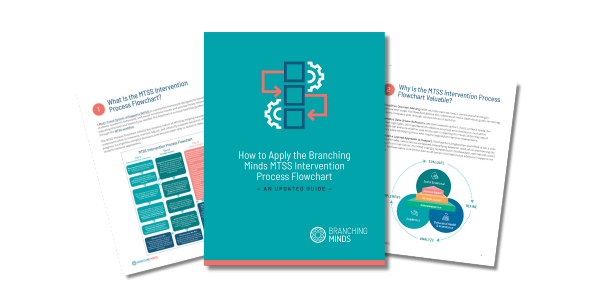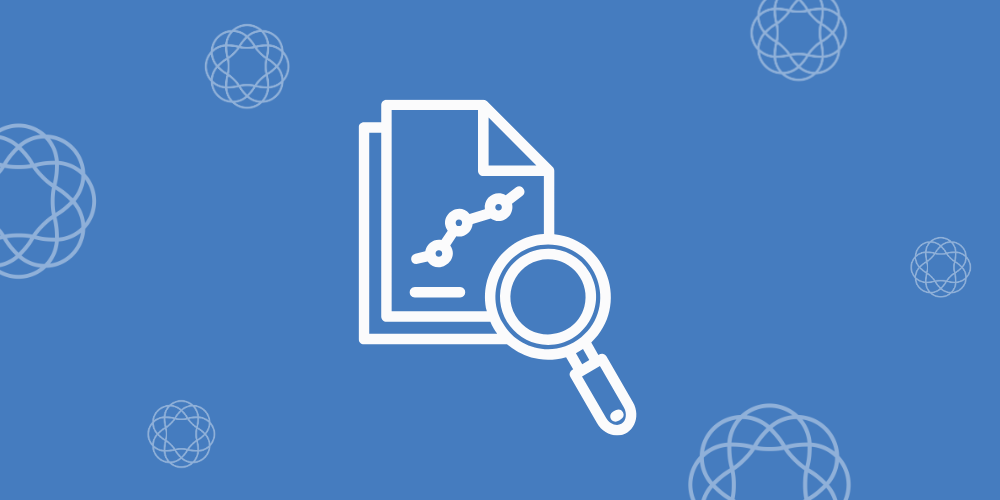What Is MTSS? Multi-Tiered System of Supports
Everything you need to know about MTSS in education and how to implement

What is MTSS In Education?
The Multi-Tiered System of Supports (MTSS) is a framework that helps educators identify students’ academic, behavioral, and social-emotional strengths and challenges and provide differentiated support for students based on their needs. MTSS in education grew out of the integration of two other intervention-based frameworks: Response to Intervention (RTI) and Positive Behavior Interventions and Supports (PBIS).
There is a growing need to bring the whole child lens to our classrooms and provide both academic and social-emotional support to all students. MTSS in schools is gaining great momentum as a solution to overcoming the challenges associated with instructional loss and as a way to drive objectivity in education.
In this guide, we explore definitions and essential elements of MTSS and provide best practice recommendations and requirements for implementing an effective MTSS framework. The guide also outlines instructions for gathering accurate and reliable data, using data to make meaningful instructional changes for students, and establishing effective MTSS teams and system-level practices.
Table of Contents
- What Is MTSS?
- What Is the Purpose of MTSS?
- What Are the Benefits of MTSS?
- MTSS vs RTI
- What Are the Essential Components of MTSS?
- What Does an MTSS Framework Look Like?
- What Are the Guiding Principles of MTSS?
- Problem-Solving in MTSS
- Data Systems in MTSS: What Are the Different Assessment Types Within MTSS
- MTSS Tiers
- Intervention Planning in MTSS
- The Three Different Types of Meetings in MTSS
- How To Build the Right MTSS Team
- How Can I Improve My MTSS?
- Improve MTSS With Branching Minds
- MTSS FAQs
What is MTSS?
According to the Center on Multi-Tiered System of Supports, at the American Institute for Research, a multi-tiered system of supports (MTSS) is a proactive and preventative framework that integrates data and instruction to maximize student achievement and support students' social, emotional, and behavior needs from a strengths-based perspective.
The Multi-Tiered System of Supports (MTSS) is a collaborative, evidence-based approach to differentiating and personalizing instruction and intervention, across academics, social-emotional learning, and behavior for all students—so that every student can achieve academic and life success.
MTSS aims to ensure all students get the right instruction and educational experience by leveraging collective knowledge and expertise to help teachers understand their learners' needs and make informed, strategic decisions that best support them.
MTSS begins with teachers assessing the skills of everyone in the class to proactively identify who may need additional support in an area (e.g., reading, math, behavior). Students receive support (research-based, targeted instruction or intervention) matched both to their skills and level of need. Student progress is monitored closely to ensure that the additional support is helping.
If the skill gap has resolved, additional support in that area is no longer required. If the skill gap doesn't improve, then the level of personalization increases, further problem solving to understand why each student struggles, and to design a customized plan to support their needs in a defined and systematic way.

MTSS is not new. Many academic experts and learning scientists are ready to share the dos and don’ts of supporting the full spectrum of student learning needs. There are 1000s of research-backed, evidence-based interventions to choose from, tons of best practices to keep in mind, and many data points to inform our data-driven decision-making.
The 2015 Every Student Succeeds Act (ESSA) recognizes the effectiveness of the MTSS framework. The goal of ESSA is to help increase the impact of educational investments by ensuring that interventions being implemented have proven to be effective in leading to desired outcomes, namely improving student achievement. ESSA defines a Multi-Tiered System of Supports as “A comprehensive continuum of evidence-based, systemic practices to support a rapid response to students’ needs, with regular observation to facilitate data-based instructional decision making. (Sec 8101(33))
There is tremendous evidence supporting the power of an effective MTSS system to improve student outcomes for struggling learners, but there is also solidly convincing research that it improves student outcomes for ALL learners. A rising tide raises all boats.
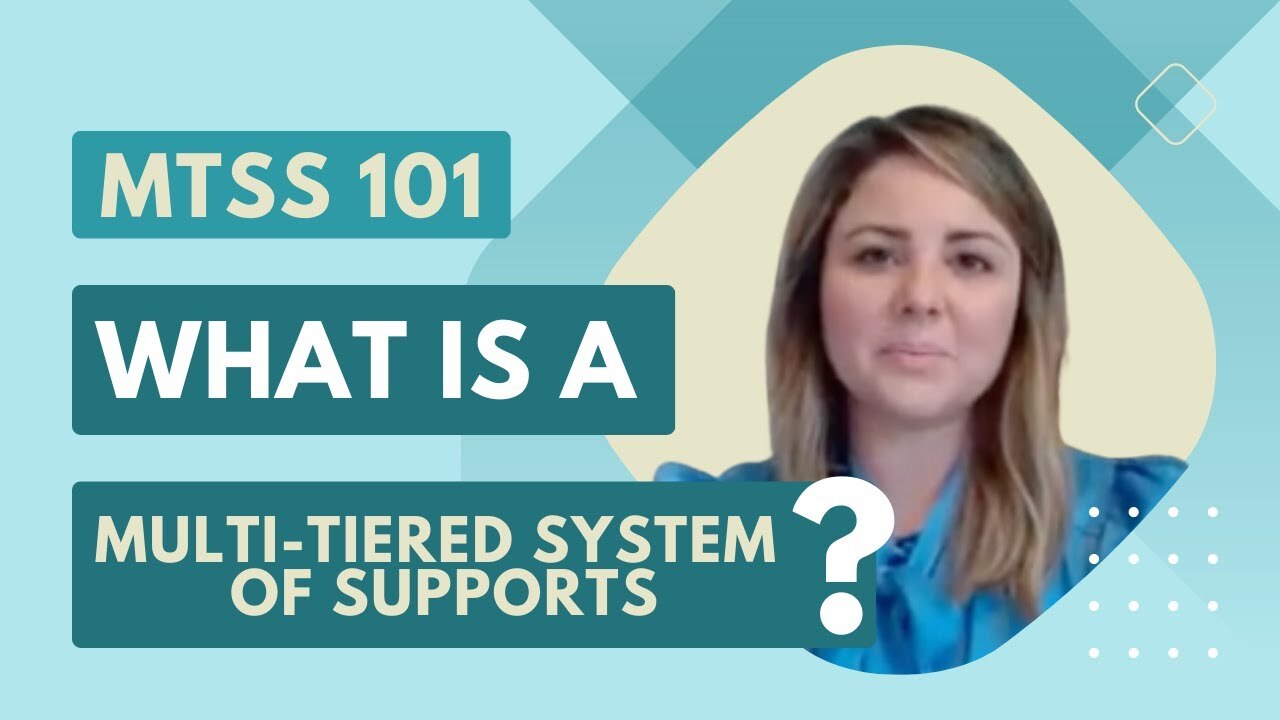
What Is the Purpose of MTSS?
The purpose of MTSS is to provide adequate and objectively tiered support for all students—while also supporting educators and administrators to more effectively and efficiently help students. MTSS intentionally encompasses the whole child—supporting students academically, social-emotionally, and behaviorally.
MTSS is a system-level initiative that helps districts across the country improve student outcomes through the use of screeners, a continuum of tiered support, progress monitoring, and data-based decision-making. And as a system-level solution, MTSS is collaborative, involving all stakeholders in data-driven decision-making to best support students.
What Are the Benefits of MTSS?
MTSS is a comprehensive system that consists of many benefits. It’s important to note that MTSS does not just benefit students, it also provides benefits for district-level and school-level staff. MTSS supports educators and education leaders in their initiatives to support their students.
1. MTSS is Designed To Help Every Student Succeed & for Every Teacher To Know How To Help Their Students
MTSS provides targeted support for the whole student academically, social-emotionally, and behaviorally. With an ongoing problem-solving process, all students are assessed in each domain to identify students who need additional support or intervention.
To implement this framework, educators use data analysis tools, such as universal screening assessments, to identify the specific skills that need to be addressed. These assessment tools also help educators determine if the Tier 1 core instruction is meeting the needs of their current population of students.
Research-based interventions help guide educators on how to deliver interventions, including frequency and duration.
2. With MTSS, Teachers Are Able to Better Evaluate Student Needs and Match Instruction, Resources, and Interventions Accordingly
MTSS depends on a continuous process of data collection that utilizes data assessment tools, such as universal screening assessments, progress monitor assessment tools, and diagnostic assessment tools.
The data gained from this process provides data insights into adjustments needed for Tier 1 core instruction delivery and intervention needs.
This data also aids educators in selecting appropriate research-based interventions that target the specific skill needed to help a student meet grade-level expectations.
3. MTSS Places a Strong Priority on Prevention
When implemented correctly, MTSS is a systemic solution. MTSS is not just used for identifying “at-risk” students needing support and providing them with support, it’s also looking at the comprehensive system of the district and/or school to identify systemic obstacles and to point out “what’s not working” as a preventative measure.
For example, a cornerstone of MTSS is a strong Tier 1 core instruction. Core instruction should aim to meet the needs of 100% of students, and an effective core instruction needs to meet the needs of at least 80% of students. By identifying areas in need of improvement in core instruction, MTSS is able to prevent more and more students from needing additional tier-level support.
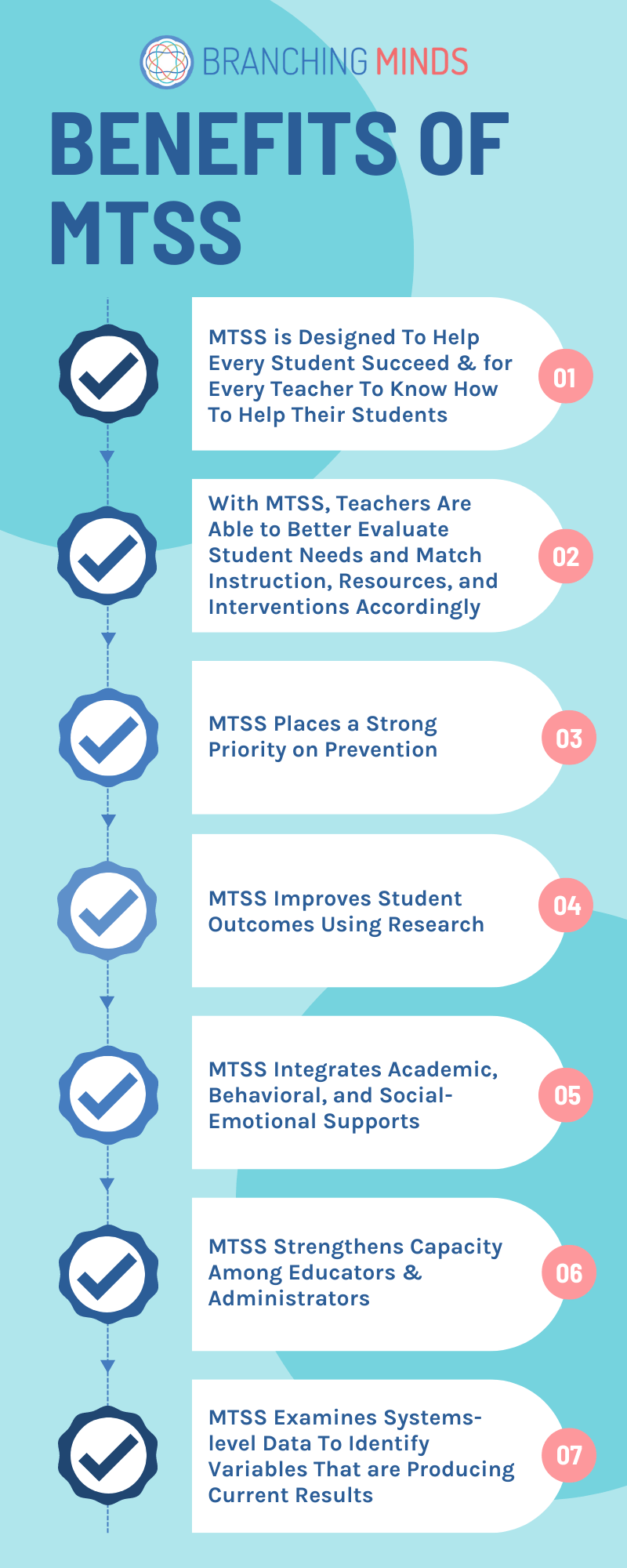
4. MTSS Improves Student Outcomes Using Research
MTSS as a framework is driven by research. To read more about MTSS research, visit the American Institutes for Research’s (AIR) research on MTSS. Additionally, check out these research articles:
- Better Together: Using MTSS as a Structure for Building School–Family Partnerships
- Research Brief: Multi-tier System of Supports (MTSS)
- Integration of Academic and Behavioral MTSS at the District Level using Implementation Science
- Applying an MTSS framework to address racism and promote mental health for racial/ethnic minoritized youth
- Implementing MTSS in Beginning Reading: Tools and Systems to Support Schools and Teachers
- The role of school improvement planning in the implementation of MTSS in secondary schools
- A Model of MTSS: Integrating Precision Teaching of Mathematics and a Multi-Level Assessment System in a Generative Classroom
5. MTSS Integrates Academic, Behavioral, and Social-Emotional Supports
MTSS encompasses the whole child, and through the use of universal screeners and diagnostic assessments, the student’s academic, behavioral, and social-emotional needs are able to be identified. Additionally, MTSS goes beyond this to provide learning supports, enrichment opportunities, and interventions for the students identified as needing the appropriate tiered level support. Through its incorporation of academic, behavioral, and social-emotional supports, MTSS is able to look at the full picture so it can provide maximum support for students, not just components of it.
6. MTSS Strengthens Capacity Among Educators & Administrators
Through its comprehensive framework, MTSS requires strong leadership, a solid cohesive foundation of resources, knowledge, and organizational structures to be implemented with fidelity. Educators and administrators grow their instructional skills when they are included in the “science of improvement,” which is a big part of MTSS. For example, their observation and diagnostic skills are sharpened as they evaluate the impact of applying focused evidence-based strategies to specific student needs.
The experience gained from analyzing MTSS data with colleagues translates back to the classroom, where those educators can then recognize skill and knowledge gaps more quickly and apply support within core instruction. The more educators and administrators study through the MTSS process, the more they strengthen their capacity.
7. MTSS Examines Systems-level Data To Identify Variables That are Producing Current Results
One component of MTSS is utilizing the MTSS model to complete the student-level, problem-solving process. However, MTSS is also used to complete a system-level, problem-solving process to establish the necessary infrastructure needed to support student success.
With readily available data collected through MTSS practice, district leaders can look at system-level problems, such as the percent of students who are meeting grade-level expectations with core instruction or the objectivity of instruction across demographic groups. This data can highlight areas of concern at the school, grade, and subject level. This allows education leaders to make proactive decisions to support challenge areas quickly and actively respond to key areas that impact student success.
What is the Difference Between RTI and MTSS?
It’s important to understand the similarities and differences between MTSS and RTI because there is an overlap between the two but there are also distinct differences worth noting. To understand the similarities and differences between MTSS and RTI, it can be helpful to go over their definitions.
A Multi-Tiered System of Supports (MTSS) wraps around an entire school. As a system-level structure, it provides academic, behavioral, social-emotional, and attendance support for all students. In MTSS, data is gathered and utilized to address academic and non-academic needs, such as attendance and social-emotional concerns, ensuring a holistic proactive approach to support.
Response to Intervention (RTI) is a multi-tier approach to the early identification and support of students with learning and behavior needs. The RTI process begins with high-quality instruction and universal screening of all children in the general education classroom.
MTSS emerged from RTI and problem-solving models that were designed to identify and provide interventions to students at-risk of failing, determine interventions that might address their needs, and provide pre-referral information for students demonstrating a need for special education services.
|
MTSS |
RTI |
|
|
Utilizes a multi-tiered system approach |
✓ |
✓ |
|
Provides a continuum of supports based on the severity of a student’s needs |
✓ |
✓ |
|
Uses universal screening to identify students in need of support |
✓ |
✓ |
|
Uses frequent progress-monitoring to track student performance |
✓ |
✓ |
|
Uses data-driven decision-making to guide the selection of evidence-based interventions |
✓ |
✓ |
|
Fully addresses social-emotional learning (SEL), behavioral health needs, and attendance |
✓ |
|
|
Places an emphasis on a strong differentiated core instruction |
✓ |
|
|
Places an emphasis on professional development |
✓ |
|
|
Involves all important stakeholders for the success of the student including educators, administrators, and family and community members |
✓ |
|
|
Includes district-wide and school-wide systemic change as needed |
✓ |
|
|
Incorporates Positive Behavior Interventions and Supports (PBIS) |
✓ |
How Are MTSS and RTI Similar?
MTSS is similar to RTI because it provides a continuum of supports for students based on the severity of their needs. Both models provide a tiered system of supports, starting with less intense interventions and moving towards more intensive ones in Tier 2 and Tier 3. Both RTI and MTSS utilize:
-
A multi-tiered system approach
-
Universal screening to identify students in need of support
-
Frequent progress monitoring to track student performance
-
Data-driven decision-making to guide the selection of evidence-based interventions
How Is MTSS Different from RTI?
MTSS offers a broader scope of services than RTI. MTSS looks at the whole child, and seeks to involve all important stakeholders for the success of the student, including family and community members. It also encompasses the entire school or district by incorporating and taking into account teacher professional development and school culture.
MTSS is different from RTI because it emphasizes quality instruction at all levels. RTI places most of its focus on providing intervention to students in need of support, and MTSS places emphasis on high-quality differentiated core instruction and focuses on prevention in addition to intervention. MTSS also requires a higher degree of intensity in intervention and support in Tier 2 and Tier 3.
MTSS is an umbrella and under that umbrella are RTI, Positive Behavior Interventions and Supports (PBIS), Social-Emotional Learning (SEL), collaboration and learning amongst educators, as well as collaboration with family and community members as part of the problem-solving process. MTSS seeks to enact systemic change at the macro and micro levels within a district and school.
What Are the Essential Components of MTSS?
According to the Center on Multi-Tiered System of Supports, at the American Institute for Research, a multi-tiered system of supports (MTSS) is a proactive and preventative framework that integrates data and instruction to maximize student achievement and support students' social, emotional, and behavior needs from a strengths-based perspective.
MTSS offers a framework for educators to engage in data-based decision-making related to program improvement, high-quality instruction and intervention, social and emotional learning, and positive behavioral supports necessary to ensure positive outcomes for districts, schools, teachers, and students.
The MTSS framework is comprised of four essential components: 1) screening, 2) progress monitoring, 3) multi-level prevention system, and 4) data-based decision-making. Depending on state law, MTSS data may also support the identification of students with learning disabilities or other special education needs.
Screening
Screening is generally conducted three times a year, to identify students who may be at risk for poor outcomes, and need additional academic, social, emotional, and behavioral support. Screening is also used to identify patterns and trends of learning and achievement at the school and grade levels.
Multi-Level Prevention System
A multi-level prevention system includes a continuum (Tier 1, 2, and 3) of integrated academic, social-emotional, behavioral, instructional, and intervention supports that are evidence-based and culturally and linguistically responsive.
Progress Monitoring
Progress monitoring uses valid and reliable tools and processes, to assess performance, quantify the improvement of responsiveness to intervention and instruction, and evaluate the effectiveness of instruction, interventions, and support.
Data-Based Decision Making
Data-based decision-making includes data analysis and problem-solving through team meetings to make decisions about instruction, intervention, implementation, and disability identification (in accordance with state law).
What Does an MTSS Framework Look Like?
An MTSS framework is composed of three tiers:
-
Tier 1: whole class data-driven differentiated core instruction,
-
Tier 2: whole-class differentiated instruction + small group targeted instruction (in addition to core instruction), and
-
Tier 3: whole class core differentiated instruction + additional targeted instruction (often small group in addition to core instruction) + intensive support.
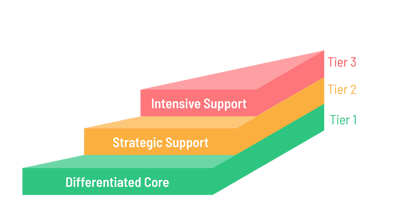
The framework takes the whole child into consideration and encompasses academics, social-emotional learning, and behavioral health & attendance. Through the use of universal screeners and diagnostic screeners, student needs are identified, and through collaboration, a SMART goal is established, and an intervention plan is created to ensure the student receives the appropriate learning supports and/or interventions. Progress monitoring assessments—standardized assessments used to assess a student’s progress towards a SMART goal and determine the effectiveness of support provided—are utilized, and the student’s intervention plan is adjusted accordingly using data-based decision making.
A student is only moved to Tier 2 when they demonstrate a need that differentiated core instruction can not meet, and a student is only moved to Tier 3 if sufficient progress is not met in Tier 2 and they’re demonstrating a need for intensive support.
It’s important to note that MTSS is a system-level framework. MTSS does not just support students but also teachers, administrators, and education leaders in providing the right tier-level support to students through its structured, systemic approach.
What Are the Guiding Principles of MTSS?
There are 7 Guiding Principles of MTSS:
1. MTSS is for ALL students
- Educators must work proactively to support students’ learning needs.
- ALL students can learn.
- ALL available resources are accessible to teach all students.
2. Leadership is vital
- Strong administrative support ensures clarity around protocol and commitment to time and resources.
- Administration supports teachers by sharing the common goal of improving instruction (core, supplemental, and intervention).
- MTSS team builds internal capacity and sustainability over time.
3. Scientific, research-based core instruction and intervention are the foundation for success
- Core Curriculum: To ensure students have the best chance at success, use strategies with a scientific research base.
- Core curriculum and instructional approaches must have a high probability of success for most students (80%).
- Implementation of core curriculum must be verifiably implemented with fidelity.
- Tiered Levels of Support: Beyond the core curriculum, match students’ instruction/support to the level and intensity of their needs. The levels of support provided to students are based on the increasing level of student needs, which is organized through a tiered framework:
- Tier 1 is whole class core instruction
- Tier 2 is whole class core instruction + additional targeted instruction (often small group)
- Tier 3 is whole class core instruction + additional targeted instruction + intensive intervention
4. Instructionally relevant, valid, and reliable assessments are critical for providing proactive and reactive support
There are 3 types of assessments, which vary in administration and use:
- Summative assessments are administered to all students annually to determine students’ mastery of grade-level standards and provide educators with information about adequate yearly progress at site and district levels.
- Universal screening assessments are administered to all students three times per year to proactively and objectively identify which students are potentially in need of educational supports/enhancements to supplement the core curriculum. Furthermore, evaluation of universal screening data is conducted to ensure the core curriculum is resulting in success for a sufficient percentage of students. These assessments should be nationally or state-normed and predictive of performance on summative assessments.
- Progress monitoring assessments are given to students receiving intervention support and are administered weekly or every other week, depending on the intensity of need. These data should come from Curriculum-Based Measurements (CBMs) because they provide a reliable and valid measure of students’ growth in a particular skill area.
5. A Response Protocol is used to make support decisions for students on a continuum of needs
- A Response Protocol refers to the method and approach used when determining student needs and how to address them--it defines, “who gets what and when.”
- The Response Protocol outlines a plan for using research-based, targeted interventions and enrichment services with increasing levels of cumulative support.
- The Response Protocol outlines the roles and responsibilities of staff and clarifies the procedures and processes within the model (e.g., requirements to intensify to a Tier 3 level of support for a student, procedures for notifying parents, etc.).
- There are three types of Response Protocols:
- A Standard-Treatment Protocol (STP) is used when all students struggling with a similar area receive the same support plan.
- A Problem-Solving Protocol (PSP) is used when a student receives an individual plan designed for their specific needs.
- A combined approach (ST/PSP) uses elements from both protocols to design additional support.
6. Data guide instructional decisions
- Data are used to align curriculum and instruction to assessment.
- Data are used to allocate resources.
- Data drive professional development decisions.
7. Educators are also respected as diverse learners
- Educators require professional development to ensure effectiveness and integrity at all levels of instruction.
- Educators receive ongoing training and support to assimilate new knowledge and skills in a diversity of ways.
- This support can be in the form of follow-up modeling and coaching.
- This support can be provided in person, via webinar, in groups, one-on-one, through tutorials, articles, etc.
- Educators anticipate and are willing to meet newly emerging needs based on student performance.

Problem-Solving in MTSS
MTSS has a methodological way of problem-solving, utilizing a Response Protocol to make support decisions for students based on a continuum of needs.
As mentioned in the section above, a Response Protocol refers to the method and approach used when determining student needs and how to address them—it defines, “who gets what and when.” It outlines a plan for using research-based, targeted interventions and enrichment services with increasing levels of cumulative support. It also outlines the roles and responsibilities of staff and clarifies the procedures and processes within the model (e.g., requirements to intensify to a Tier 3 level of support for a student, procedures for notifying parents, etc.).
3 Types of Response Protocols
There are three types of Response Protocols:
-
A Standard-Treatment Protocol (STP) is used when all students struggling with a similar area receive the same support plan.
-
A Problem-Solving Protocol (PSP) is used when students receive an individual plan designed for their specific needs.
-
A combined approach (ST/PSP) uses elements from both protocols to design additional support.


4-Step MTSS Problem Solving Model
The combined Standard Treatment Protocol / Problem-Solving (STP-PS) Model with Branching Minds (BRM) drives the decisions made in the MTSS system, and includes 4 steps:
- Problem Identification (“Who and what are we concerned about?”): the difference between what learning and/or behavior is expected and what actually occurs is clearly defined.
- Problem Analysis (“Why do we think the problem is occurring?”): multiple sources of data are used (e.g., formative and summative assessments, attendance data, the BRM Insight Surveys, etc.) to generate possible cause(s) of the problem.
- Plan Implementation (“What can we do about it?”): using the BRM platform, an intervention plan is developed collaboratively and implemented. The plan contains learning goals, support activities that are research-based strategies from the BRM library that maximize the likelihood of success, and a plan for monitoring progress.
- Plan Evaluation (“Was our support successful?”): Progress data are reviewed to determine if the plan was delivered with fidelity and the extent of impact in closing the gap toward expected performance. If a positive impact is not evident, the problem-solving process begins again.
It’s critical to understand that MTSS is based on this premise: the earlier we can identify a problem, analyze it so we can best understand our learners’ needs, implement a plan providing each student the level of support they need using research-backed interventions matched to their specific challenges, and frequently monitor for fidelity and effectiveness, the higher the likelihood we can help our students achieve success more easily, more quickly, and more commonly within the general education setting. MTSS is how we provide an objective and successful education for ALL students.
Data Systems in MTSS: What Are the Different Assessment Types Within MTSS
Instructionally relevant, valid, and reliable assessments are critical for providing proactive and reactive support. There are 3 types of assessments, which vary in administration and use:
- Summative Assessments Summative assessments are administered to all students annually to determine students’ mastery of grade-level standards and provide educators with information about adequate yearly progress at site and district levels.
- Universal Screening Assessments Universal screening assessments are administered to all students three times per year to proactively and objectively identify which students are potentially in need of educational supports/enhancements to supplement the core curriculum. Furthermore, evaluation of universal screening data is conducted to ensure the core curriculum is resulting in success for a sufficient percentage of students. These assessments should be nationally or state-normed and predictive of performance on summative assessments.
- Progress Monitoring Assessments are given to students receiving intervention support and are administered weekly or every other week, depending on the intensity of need. These data should come from Curriculum-Based Measurements (CBMs), because they provide a reliable and valid measure of students’ growth in a particular skill area.
Related Resources

Article
Are MTSS and Special Education (SPED) the Same Thing?
MTSS and special education (SPED) are rooted in the foundation of creating an equitable learning environment for all learners.
Read the article
MTSS Tiers
A three-tiered service delivery system is necessary to efficiently and effectively support all children, not just those who struggle in school. The three-tiered system of service delivery is crucial in the attempt to ensure all students achieve at high levels and all students achieve college and career readiness.
The first step in building an MTSS system involves examining system effectiveness, which must occur prior to examining students individually. This section describes each tier in detail, and how to examine the effectiveness of a school’s service delivery system.
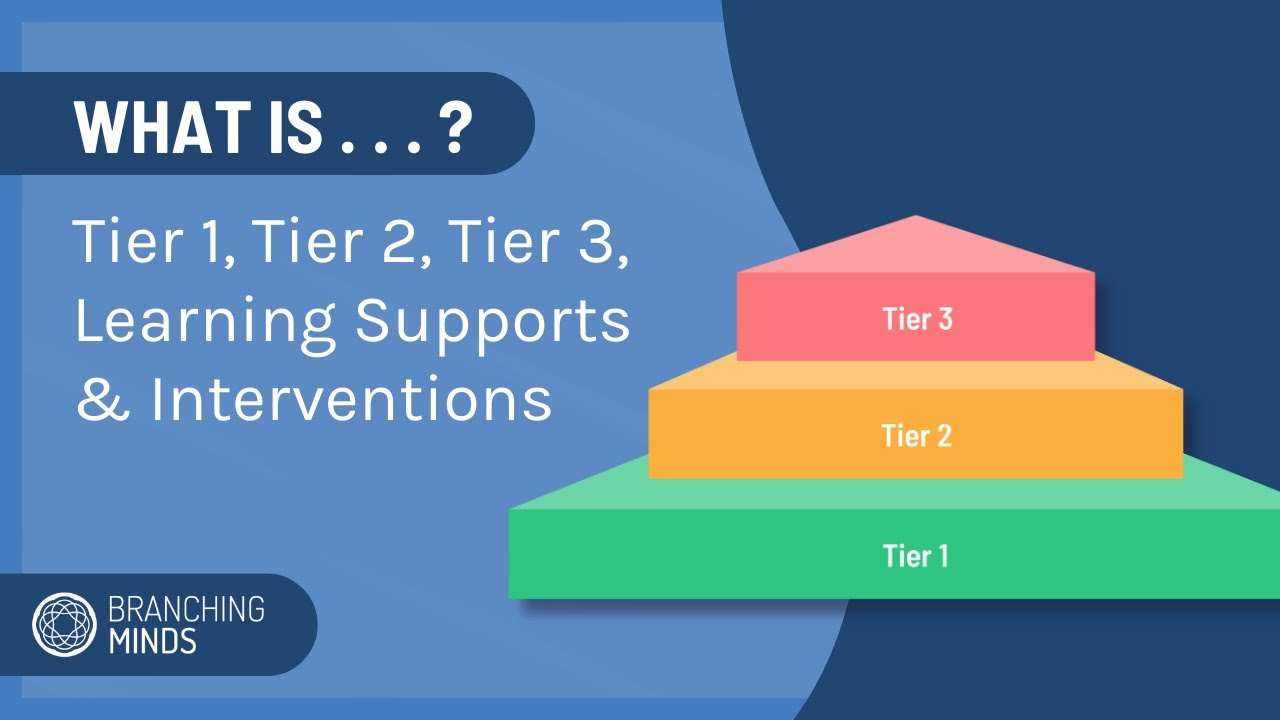
Tier 1: Core Instruction
At Tier 1, all students receive scientific, research-based core instruction implemented with integrity and emphasizing grade-level standards and school-wide behavioral expectations. Instruction at Tier 1 should be explicit, differentiated, and include flexible grouping and active student engagement. High-quality instruction is essential to ensure that 80% of students’ needs are met at Tier 1. Features of high-quality, research-based instruction include (Chard et al., 2008):
- Standards-Based Curriculum: a curriculum based upon state standards.
- Systematic Explicit Instruction: Skills are taught from less to more complex using direct, clear, and concise instructional language.
- Differentiated Instruction: Students have different levels of background knowledge and school readiness; differentiated instruction engages each student in active learning according to his/her needs. The content of instruction, delivery of instruction, and targeted level of instruction can be differentiated. (For more information, check out this blog: The Differentiation Deal: Making a Case for Differentiation in the Classroom.)
- Flexible Grouping: A combination of whole group, small group, and individual instruction allows teachers to create fluid groups that meet the needs of all students.
- Active Student Engagement: Ensuring all students are actively involved during instruction and are not passive recipients; this can be accomplished with high rates of opportunities to respond, ample time to practice skills, and prompt corrective feedback. (Want Tier 1 Engagement Strategies? Check out: Top 10 Student Engagement Practices For Tier 1 in MTSS)
- Classroom Behavior Strategies: Proactively and explicitly teaching the expected behaviors and routines, frequent use of reinforcement and praise (4:1 positive to negative feedback loop), quick and efficient transition times, and consistent instructional response to misbehavior.
A solid Tier 1 should be sufficient to help 80% of students meet or exceed grade level expectations as measured by a standardized summative assessment. If Tier 1 instruction is not successful in meeting the needs of 80% of the school’s population, the school team should evaluate the quality of the curriculum and its delivery and also consider possible solutions to create a better match between students’ needs and the core curriculum and instruction (e.g., improving explicit instruction, differentiation strategies, use of flexible grouping, and maximizing active student engagement).
Learn More About Core Instruction

Guide
The MTSS Guide to Core Instruction
Use core instruction to maximize student success.
Download guide
Tier 2: Targeted Group Intervention
At Tier 2, students identified as being at-risk academically or behaviorally through universal screeners are provided scientific, research-based interventions in addition to the core. Approximately 5-15% of students will need supplemental instruction at a Tier 2 level of support to become proficient. Tier 2 interventions are implemented with groups of students demonstrating common skill deficits or social/emotional/behavioral risk characteristics. These students should be observed on a platform or a system where a collaborative intervention plan is developed, monitored, and documented.
Targeted group interventions typically involve an additional 60-90 minutes of instruction (outside of core instruction) provided each week (e.g., two to three 30-minute intervention periods). Targeted group interventions must be more explicit: more intensive than core instruction; more supportive in the form of encouragement, feedback, and positive reinforcement; carefully scaffolded; and ideally occur in groups of approximately 3 to 5 students, for elementary, and 6 to 8 students or tier 2 support classes broken into a few groups of 6 to 8 students, for middle and high schools.
Tier 3: Intensive Individualized Intervention
Students who have not demonstrated progress with targeted group interventions at a Tier 2 level of support require more time in more intensive interventions. Tier 3 interventions are distinguished from Tier 2 interventions because they are individualized based on data collected in individual problem solving, and occur with smaller student-teacher ratios (e.g., ideally 1-on-1, however, groups of 3 to 5 students or a larger group broken into a few groups of 3-5 students, is acceptable for middle and high schools), and possibly occur for a longer duration of time (e.g., more daily minutes or more weeks spent in intervention). About 1-5% of students will require this level of intensive support.
Tier 3 intervention plans include more than what occurs during intervention time. They also include strategies for maximizing student outcomes during core instruction or Tier 1, as well as supports to use at home or in the community.
Tier 2 and Tier 3 Resources
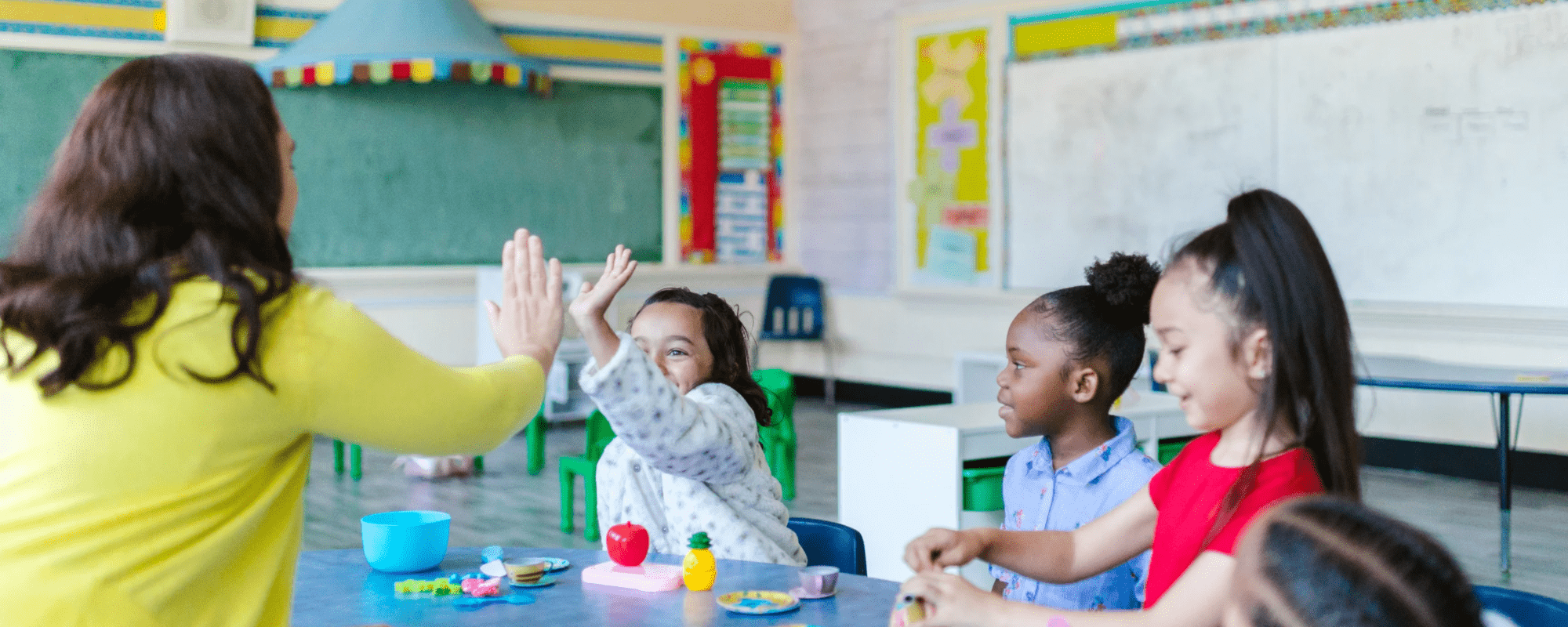
Article
What You Need To Know About Utilizing Tier 2 in MTSS
Tier 2 instruction and interventions should be high-quality, evidence or research-based, and supplemental to core instruction.
Read the article
Intervention Planning in MTSS
Teachers spend a lot of time and effort discussing student needs, creating plans, providing differentiated support, and documenting the work; however, without the right intervention plan, the work becomes a documentation process instead of the intended problem-solving practice.
The key components of successful intervention plans are
1. Goals
When setting goals, a helpful acronym to use is SMART, to ensure that each goal is Specific, Measurable, Attainable, Relevant, and Time-bound. When goals include these features it makes it clear when problem-solving whether or not the goal was achieved.
2. Progress Monitoring
Progress monitoring is the process of tracking student growth towards the goal. These are typically short, skill-based assessments that are administered using alternate forms that are also comparable in difficulty, instead of giving the exact same assessment multiple times. The assessments should also be reliable and valid in that they are able to accurately discriminate between growth, decline, and stagnation in a specific subject area. This ultimately provides reliable and valid information that can be used in problem-solving meetings as to whether or not the student is responding to the intervention and showing improvement.
3. Interventions
Intervention plans always need to include the actual intervention that will be used to help students reach their goals. In MTSS/RTI, interventions are targeted instructional programs, activities, lessons, strategies, or tools used to improve a specific skill.
It is also important to point out what strategies are NOT interventions. In MTSS homework help, test prep, and reviews of core content are not considered interventions. Although they are included in intervention plans, locations and people are not the actual interventions themselves. For example, only including in an intervention plan that the student went to the library for support or met with an academic support teacher does not identify what was done to support the student.
Therefore, when planning these intervention activities it is important to again think about what information will be needed for future problem-solving meetings. For example, what was done? What skill was it trying to target? How long, how frequent, and where?
Many of these key pieces of information for problem-solving are not only important when developing the plan, but are also critical when selecting interventions.
Practice Spotlight
How the practice of MTSS intervention planning has evolved in Mineola UFSD,with the support of Branching Minds
Request a demo to learn about How to select and document evidence-based supportsfor struggling students on the Branching Minds platform.
The Three Different Types of Meetings in MTSS
An effective MTSS practice is comprised of three different types of meetings that have three different functions and agendas:
1. The School Level MTSS Meeting
This meeting is conducted three times a year following the administration of universal screening assessments. The goal of this meeting is to understand the health of school-level MTSS practice by looking at the percent of students who are adequately being served by the core, the objectively' of instruction across demographics, grades, and classrooms, and improvement in student outcome measures since the last meeting. These metrics are used to evaluate the quality of practice across tier 1, 2, and 3 levels of support and guide school-level improvement plans.
2. The Grade/Content Team MTSS Meeting
This meeting is conducted by each grade or content team on a monthly basis to discuss all students receiving tier 2 and 3 level support. The goal of this meeting is to ensure students at a greater level of risk are receiving support and making progress, that patterns/trends in student growth are identified, and that plans are adjusted or support is provided to teachers based on observed trends in student need.
3. The Individual Problem-Solving MTSS Meeting
This meeting provides the time and space for individualized deep dive problem-solving for students not making sufficient progress when supported by the Grade/Content Team, e.g. students not making progress after receiving tier 2 and tier 3 level support
|
MEETING TYPE |
SCHOOL LEVEL MTSS MEETING |
GRADE/CONTENT TEAM MTSS MEETING |
INDIVIDUAL PROBLEM-SOLVING MTSS MEETING |
|
GOAL |
To evaluate school-wide health and wellness of an MTSS practice. |
To monitor the progress of students in need of Tier 2 support, and to look for trends in support needs at the system, teacher, or student level. |
To dive deeper into problem-solving for students not making sufficient progress, and to create/revise intervention plans. |
|
DURATION/ FREQUENCY |
1 hour, 3x per year (post-universal screeners) |
1 planning period a month |
Weekly or bi-weekly ½ or full day meetings (depending on the size of the Tier 3 support population) |
|
ATTENDANCE |
|
All teachers and specialists who are working with students receiving Tier 2 support in that grade or content area |
|
|
AGENDA |
|
First meeting after screener
Follow-up meetings
|
**Should avg 4-5 students in a ½ day, or 8-10 students in a full day |
Strengthen your MTSS Meeting with these Resources
.jpg?width=500&height=500&name=Better%20MTSS%20Meetings%20Blog%20(preview).jpg)
Article
How to Have Better MTSS Meetings
How MTSS meetings can rise above the daily challenges districts face to create real value for students and educators alike.
Read the article
How To Build the Right MTSS Team
The MTSS team is a school-based, problem-solving team; it is the engine that drives the MTSS system. The MTSS team proactively addresses system needs by reviewing school-wide data (within grade levels and classrooms) and supports individual student growth by helping to monitor progress and make decisions for students at Tier 3.
The site administrator designates the composition of the MTSS team. MTSS team membership is determined both by standing members who contribute expertise from their respective disciplines and those who may be invited to address a specific concern. Examples of standing members on the MTSS team include: administrator, general education teacher, school psychologist/counselor, dean, content area specialist, ELL teacher, special education teacher, and grade-level or department representatives.
MTSS Team Duties Are as Follows:
Meet regularly with a structured agenda that varies throughout the month to:
-
Review universal screening data;
-
Review school-wide data, consider feedback and concerns from PLCs, and make data-based decisions;
-
Provide input on professional development as it relates to the school’s MTSS system and Tier 1 needs;
-
Provide input regarding school site intervention/enrichment schedule, curriculum, and/or course offerings;
-
Support grade levels/departments in serving students during intervention blocks in collaboration with general education teachers;
-
Discuss and communicate with the site administrator on issues relevant to the MTSS process;
-
Consult and collaborate with administrators, counselors, teachers, and parents about MTSS, problem-solving process, and procedural integrity;
-
Hold problem-solving meetings (that include parents) for individual students;
-
Refer students for comprehensive special education evaluations when data indicate this step is warranted.
The MTSS Teams: Staff, Roles, and Responsibilities
Critical to the functioning of an effective MTSS team is communication and collaboration between all school personnel. It is important to remember as we identify roles within an MTSS system that, as educators first, we all own the success of all students.
|
ROLE |
DUTIES |
Administrative Representative |
|
MTSS Coordinator |
|
Grade-Level/Content Area Representative |
|
Specialists (e.g., ELL teacher, speech/language pathologist, intervention teacher, counselor, behavior specialist) |
|
Classroom Teacher |
|
Article
The Future of MTSS Student Support Team Meetings is Here
Conquer your MTSS meetings with purpose-driven AI that delivers! Our AI assistant transforms Tier 2 and 3 MTSS meetings into efficient and productive sessions.
Read the article
How Can I Improve My MTSS?
It’s no secret that MTSS has many components, and with the many components, it can be challenging to implement MTSS with fidelity. Because MTSS is a comprehensive continuum of supports, there are various areas that may need improvement. So the shorter answer to this question is it depends on where a district or school is at, where they want to go, and what components need to be improved for them to get there. There may only be a few, there may be many, and each district may be unique. But let's break down a few challenge areas Branching Minds often see as areas for improvement.
Challenge #1: Analyzing Current Core Curriculum Practices
The core curriculum is the collection of strategies used routinely with ALL students in a general education setting. Schools and districts implementing MTSS look to their core curriculum to meet the needs of at least 80% of their students. To tackle this challenge and understand if the core curriculum is serving the student body, ask the following questions:
-
Is there a core curriculum in place, and if so, is it being used with fidelity?
-
Are instructional best practices such as differentiated instruction being used consistently?
-
Are universal screeners being used routinely?
Challenge #2: Creating New MTSS Processes
As we work to create new MTSS processes to meet all student's needs (and concurrently reduce fatigue and create efficiency for teachers), it’s essential to analyze all current meetings teachers are required to attend. Many current meetings can be trimmed (or removed) to reduce redundancy by moving to the following three student support MTSS meeting types.
-
The Grade/Content Team MTSS Meetings: These meetings are facilitated by grade level/content level teams and can be held monthly to create intervention group plans, identify patterns of need within the grade and/or content area, and monitor student progress.
-
The Individual Problem-Solving MTSS Meetings: These meetings are facilitated by assigned teachers and can be held weekly or biweekly (depending upon the number of students with needs) and used to create and evaluate plans for individual students.
-
The School Level Meetings: These meetings are facilitated by leadership and can be held three times a year after each benchmark screening period. The leadership team should use these meetings to discuss the evaluation of tier movement, growth, and objectively of tiers across the school.
By transitioning to this streamlined approach, leadership can remove extraneous meetings as the above meeting types should cover all student needs.
Challenge #3: Infrastructure Alignment
Infrastructure alignment is an overlooked yet vital step in setting the stage for successful MTSS foundations. The clarity that the alignment process brings, offers a path to maximize overall effectiveness, both within the MTSS adoption itself, as well as its integration with schoolwide functionality. The objective of bringing resources to help every student meet their goals is most successful when schools have aligned the multiple layers of resources and programs that schools employ to support their students.
Alignment, by definition, considers movement in a straight line, which we all know is the shortest distance between two points. But, alignment can also be seen as holding and honoring positions of agreement; arguably the most effective way to implement any systemic change, including moving forward with consent from all parties.
When there is a successful adoption of MTSS, each component cohesively works in a symphony; the universal pre-screen is administered and analyzed, needs analysis are completed and utilized, student strengths and growth edges are assessed, data is used to create interventions, support plans are delivered, and progress monitored with fidelity and finally plan adjustments are made to achieve success for students. When there is complete alignment, all the parties involved benefit, including the student, school community, and all initiative stakeholders.
Here are some tried and tested steps to launch the alignment of MTSS at the school and district level:
- Name the resistance
- Create a plan
- Identify and name all school efforts, programs, and processes
- Identify the stakeholders
- Align assessment and other required data
- Communicate concisely, and more often than you think necessary
- Organize
Read more in this article: Infrastructural Alignment for MTSS
Challenge #4: Efficiently Find and Implement Effective Interventions and Tracking Their Progress
Intervention strategies can be easily googled and subsequently taught; however, how do teachers know if they will actually work? Interventions can have varying levels of evidence behind them—some are robust and research-based, and others may have very little evidence of success. When educators use strategies with little or no research base, valuable instructional time gets lost waiting for the support to impact student progress over time.
To determine if a favored intervention is research-based, educators can search for ESSA (the Every Student Succeeds Act) curated interventions. ESSA was developed to help educators select interventions that are grounded in research. The duration and frequency of intervention support are based upon students’ needs and the research-driven recommendations.
Additionally, progress monitoring assessments to measure intervention effectiveness should be administered weekly or biweekly, depending upon the students’ needs. It is critical to regularly create the time and space for reviewing progress monitoring data to determine if the intervention(s) provided needs to be adjusted/changed.
Challenge #5: Managing the Change Management Processes
Successfully managing the challenge of the change management process is critical in transitioning from a traditional support model to MTSS. You may have heard the old phrase "...if you always do what you've always done, you'll always get what you've got." To avoid this from happening and ensure success, leadership must thoroughly think through and plan the change management process. The following tips are essential when engaging in change management in schools:
-
Find exemplars for modeling best practices and collaboration;
-
Concisely and frequently communicate policy changes;
-
Explain the "why" behind the change (e.g., for MTSS);
-
Check-in regularly through quick surveys and questionnaires to see how the new policies are going; and
-
Create individual touchpoints with those that may be resistant to change
When change occurs, some may feel overwhelmed or tempted to slip back into old patterns. As a result, thoroughly thinking through the above bullets can help avoid this from happening and instead create excitement about providing a wraparound foundation to meet all students' needs.
Improve MTSS With Branching Minds
MTSS is not a new process, but it is an ever-improving & evolving research-backed process with the goal of providing adequate and tiered support for all students—while also supporting educators and administrators to more effectively and efficiently help students. MTSS is a system-level initiative that helps districts across the country improve student outcomes through the use of screeners, a continuum of tiered support, progress monitoring, and data-based decision-making. And as a system-level solution, MTSS is collaborative, involving all stakeholders in data-driven decision-making to best support students.
MTSS can help districts:
-
Support every student to succeed & for every teacher to know how to help their students
-
Better evaluate student needs and match instruction, resources, and interventions accordingly
-
Place a strong priority on prevention
-
Improve student outcomes using research
-
Integrate academic, behavioral, and social-emotional supports
-
Strengthen capacity among educators & administrators
-
Examine systems-level data to identify variables that are producing current results
The Branching Minds MTSS/RTI system-level education platform brings together innovative, easy-to-use technology with the latest insights from the learning sciences to help drive student and school success, while making teachers' and administrators' work easier and more effective. Branching Minds connects data, systems, interventions, and stakeholders so that educators, administrators, and families can work better together to support students' holistic needs. Learn more about Branching Minds' MTSS software platform.
Make MTSS Easy, Efficient, and Effective With the Branching Minds Web Platform
Transform your district's MTSS solution with personalized intervention plans, powerful collaboration tools, and easy-to-understand reporting. We are more than just a platform, we are a system-level partner.
MTSS Software DemoMTSS FAQs
MTSS acts as an umbrella that includes a few other tiered systems of support such as Response to Intervention (RTI)—a multi-tier approach to the early identification and support of students with learning and behavior needs; and Positive Behavioral Interventions and Supports (PBIS)—a preventative framework for supporting the development of positive and prosocial behaviors in schools and classrooms.
An MTSS intervention is an intentional, research, or evidence-based program, instructional activity, or strategy to target a specific academic/social-emotional/behavioral skill.
Interventions are delivered with a specific frequency and duration over a defined number of weeks, depending on the level of need. Interventions may be delivered in a variety of contexts such as small groups, one on one, afterschool, and tutoring.
For more information about the MTSS intervention process, check out the MTSS Intervention Flowchart & Guide.
During the implementation of MTSS, creating a plan to share information with families and community members about the school's approach to MTSS in a clear and accessible format is essential. Make sure to define key terms needed to level-set an understanding of MTSS. Visuals such as graphs, flowcharts, and easy-to-understand flyers are great tools to get the word out on why MTSS is necessary, how MTSS will impact students, and the schedule of expected timelines/communications. The goal is to help families understand that MTSS encourages schools to plan and allocate resources so that ALL students receive the instruction they need.
Here are a few essential MTSS resources to share with families and parents:
-
Download this MTSS Guide to share with them
A few guiding points to touch on when communicating with families and parents about MTSS are the student's tiered needs, curriculum and academics, MTSS data, and social-emotional learning (SEL) support for the whole child.
For more information, check out these resources:
The MTSS process consists of students receiving strong differentiated core instruction in the everyday general education classroom, consistent universal screening to identify students’ needs, and if students’ needs are identified then the creation of student support plans and intervention plans are created, while a student is receiving intervention progress is frequently monitored, and decision-makers interpret and data and adjust instruction and support plans according to a student’s need.
In MTSS, an effective intervention should be targeted, research-based, and chosen based on alignment with core instruction; be specific for individuals or students in small groups, and be coupled with an intervention plan which accounts for scheduled progress monitoring. Interventions should also be used in conjunction with SMART goals and progress monitoring.
Want us to email you a copy?
Fill out the form, and we will send you a PDF version of this guide














.png?width=500&height=500&name=MTSS%20Handbook%20Blog%20(preview).png)
.png?width=1000&height=500&name=What%20it%20Takes%20for%20MTSS%20to%20Work%20(4).png)



